This post may contain affiliate links. See my disclosure policy.
This melt-in-your-mouth Dutch Oven Pot Roast is made by slowly braising potatoes, carrots, and beef in a mouthwatering combination of red wine, fresh herbs, beef broth, and fatty beef drippings. Easy to make, this classic Sunday pot roast is a true one-pot meal and the perfect comfort food.
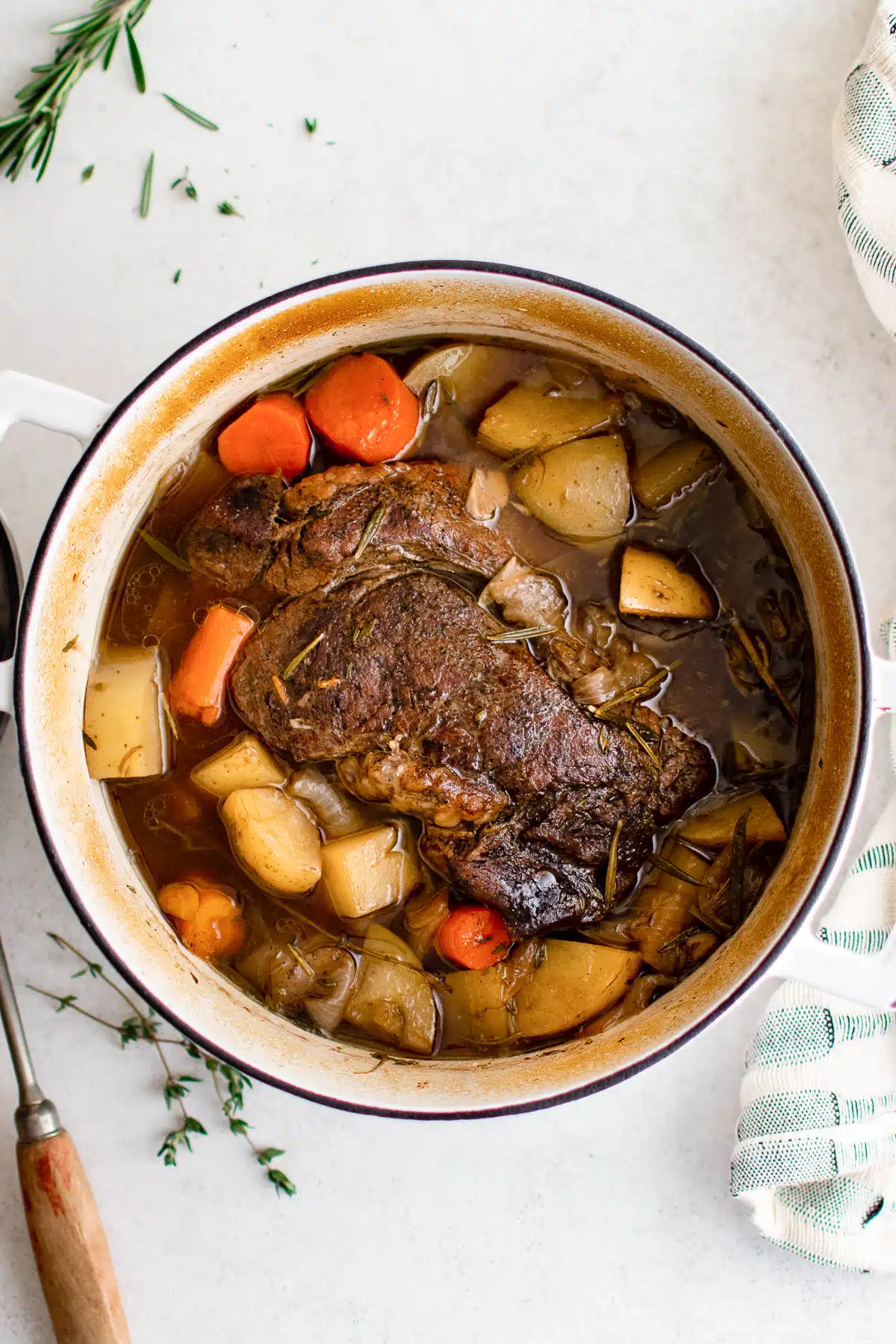
Best Pot Roast Recipe
Sunday night pot roast dinners bring back so many childhood memories. Back then, my favorite part of the entire meal was the carrots. I would eat them all. Now, I love everything about this easy family dinner (especially when it involves sopping up leftover gravy with chunks of buttered bread).
Most of all, though, I just really appreciate that it’s easy to make and it’s something my whole family will enjoy. I mean, motherhood, right?
But really, leftovers are great, cleanup is easy, and it’s customizable. You’ll love it!
Table of Contents
What is a pot roast? How is it different from a beef stew?
A pot roast is a type of braised beef dish where tough cuts of meat are first pan-seared and then slowly cooked in a liquid, usually using a Dutch oven or slow cooker. It’s a two-part cooking process similar to stewing, but with braising, less liquid is used, and typically the meat isn’t entirely submerged.
Pot roasts like this one are traditionally cooked with carrots, onions, and potatoes and are also known as “Yankee Pot Roasts”. The potatoes are added in the last 30-45 minutes of cooking to prevent them from becoming overcooked.
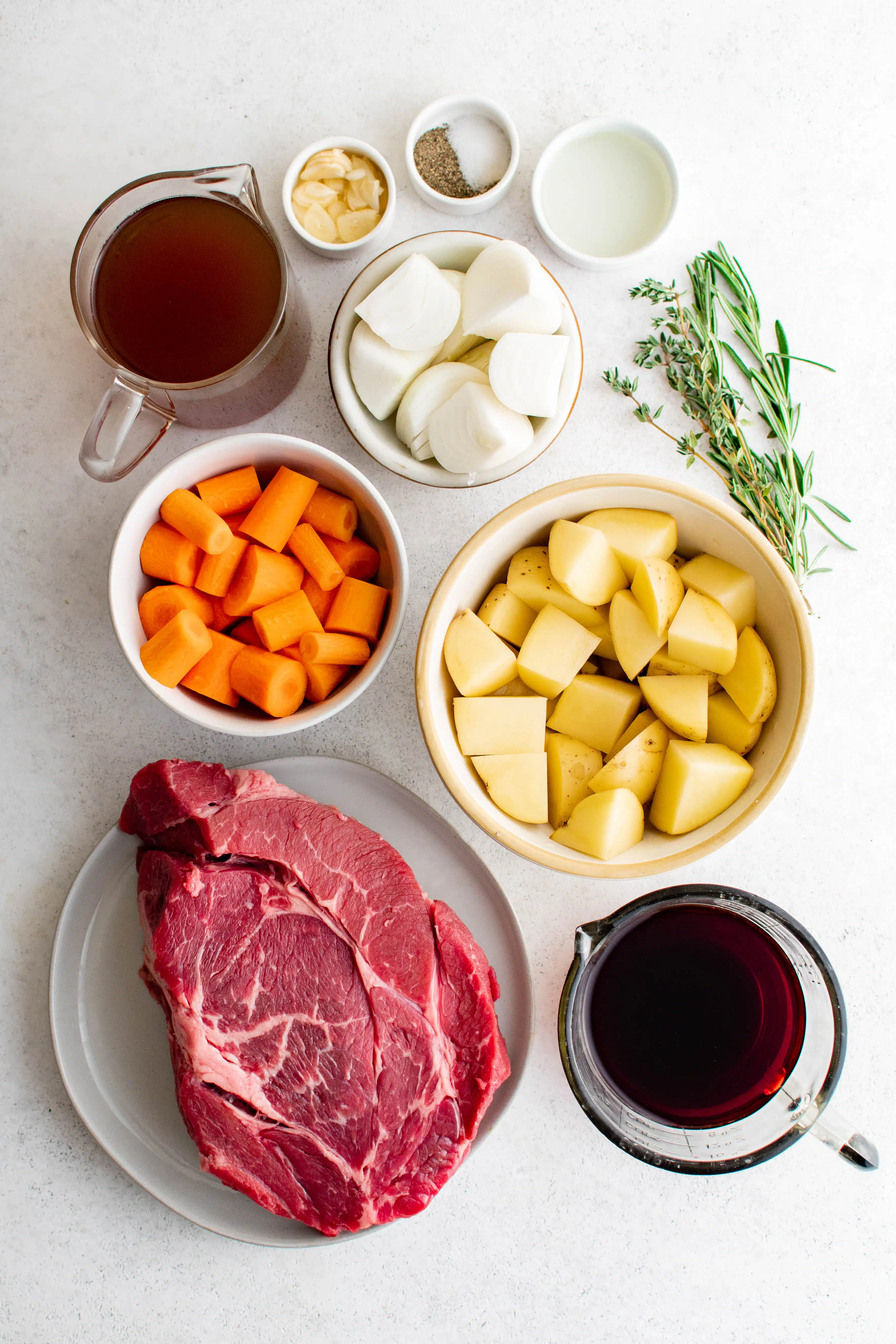
Key Ingredients
You can find the full list of ingredients, specific measurements, and full recipe instructions in the printable recipe card below.
Beef: Chuck roast is the more common (and popular) cut of beef for pot roast, but you can also use a brisket or a round roast. I prefer boneless chuck roast, but you can certainly use bone-in if that’s what you prefer.
Veggies: You’ll almost always find onions and carrots in a pot roast. My mother-in-law adds celery and sometimes I’ll add parsnips or butternut squash. Remember to chop your veggies into big pieces so that they don’t fall apart over the course of cooking.
Potatoes: Sometimes I’ll add potatoes (Yukon gold, baby potatoes, red potatoes) directly to the roast in the last 30-45 minutes of cooking (adding them later prevents them from overcooking) or I’ll replace the potatoes with extra veggies, and serve it with mashed potatoes.
Red wine: If you prefer not to cook with wine, simply replace it with extra beef stock. Easy peasy.

How to Cook Dutch Oven Pot Roast
- Place the chuck roast on a large plate and pat it dry with paper towels. Once dry, generously season the entire roast with kosher salt and black pepper.
- Place a large oven-safe pot or Dutch oven over medium-high heat. Add a couple of tablespoons of oil and add the seasoned roast.
- Sear the roast on each side until brown, about 6-8 minutes per side, then remove the roast from the pot and set aside.
- Preheat your oven to 325 degrees Fahrenheit.
- Return the same pot or Dutch oven to medium heat. Add the onions and carrots to the pot and sauté for about 5 minutes or until they start to soften a bit.
- Add the salt, pepper, garlic, fresh thyme, and rosemary to the pot and pour in the beef broth and wine and bring to a simmer for 5 minutes.
- Place the browned roast on top of the vegetables and cover the pot with a lid or foil and place in the preheated oven.
- Cook the roast for approximately 3 hours then carefully remove the lid and submerge the potatoes in the broth. Cover and continue to cook for another 30-60 minutes or until the potatoes are fork tender and the roast falls apart when you pierce it with a fork.
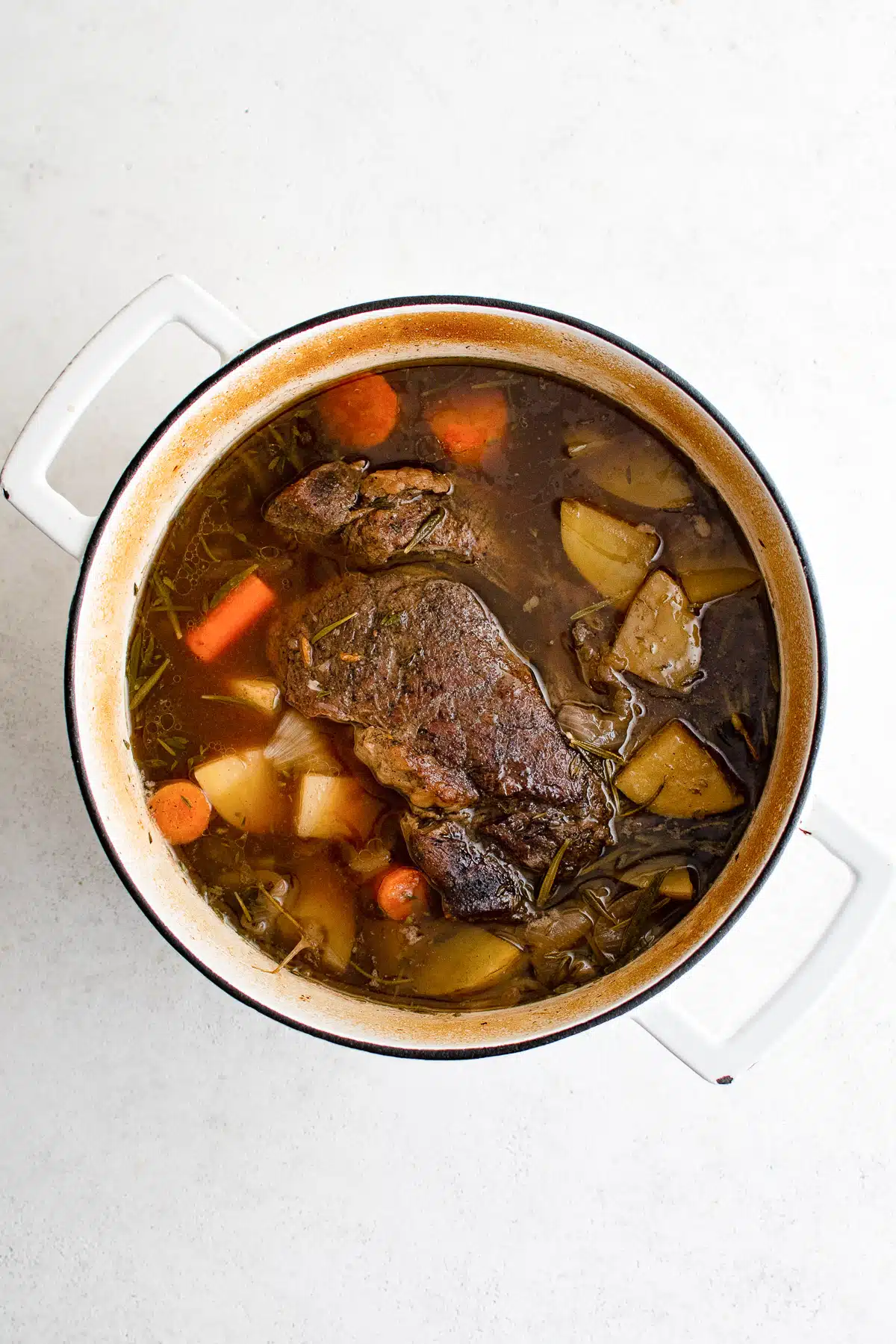
Cooking Tip
Use a heavy cast iron Dutch oven with a tight-fitting lid. Dutch ovens are particularly good for the long, slow cooking of meats and roasts. I love my Lodge 7.5-quart enameled Dutch oven.
Storage and Reheating
Storage: Keep leftovers stored in an airtight container in the refrigerator for up to 4 days.
Freezing: Allow leftovers to cool before transferring them to a freezer-safe airtight container in the freezer for up to 2 months. For best results, freeze without the vegetables as they do not thaw and reheat well.
Reheating: Reheat leftover pot roast in the microwave or in a preheated 325-degree Fahrenheit oven. For best results, reheat the gravy separately on the stovetop over medium heat until hot.

How to Serve Dutch Oven Pot Roast
This pot roast already has everything you need for a fabulous meal – juicy meat, veggies, and starchy potatoes- so it doesn’t really need anything else. That said, sometimes I’ll serve it with a loaf of crusty bread to sop up any leftover juices or a fresh green salad.
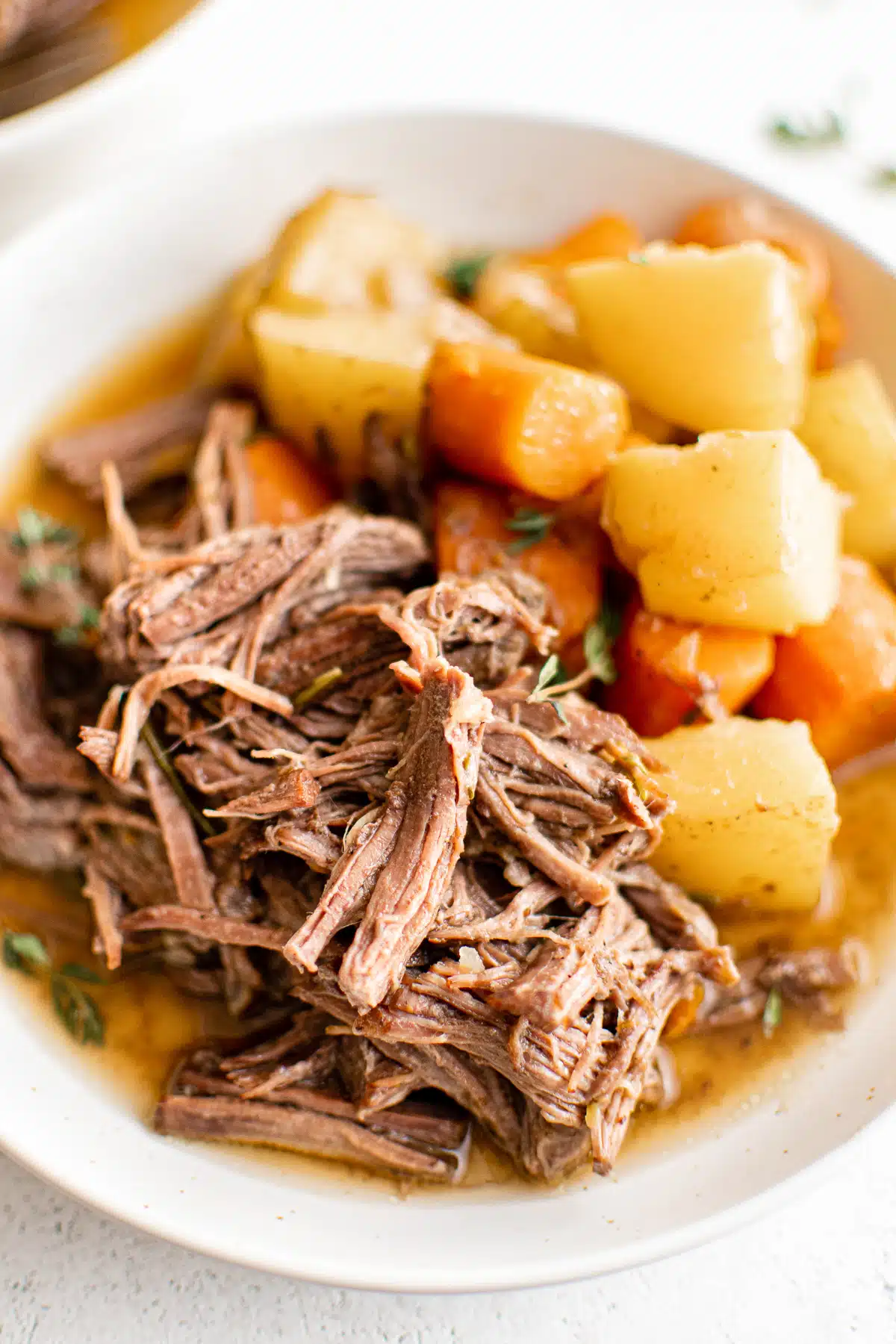
More Amazing Beef Recipes
- Guinness Beef Stew
- Vegetable Beef Soup
- Beef Stew Recipe
- Mississippi Pot Roast
- Beef Barley Soup
- Instant Pot Beef Stew
- Braised Short Ribs
If you try making this Dutch Oven Pot Roast Recipe, please leave me a comment and let me know! I always love to hear your thoughts.

Dutch Oven Pot Roast Recipe
Ingredients
- 3 pounds beef chuck roast
- 1 teaspoon salt, plus more for seasoning the roast
- 1 teaspoon ground black pepper, plus more for seasoning the roast
- 2 tablespoon vegetable oil
- 2 medium onions, peeled and quartered
- 3 large carrots, about a ½-pound, peeled and cut into 1-inch pieces
- 3 cloves garlic, peeled and sliced
- 4 sprigs fresh thyme
- 2 sprigs fresh rosemary
- 2 cups beef broth
- 1 cup dry red wine, like a Cabernet Sauvignon or Pinot Noir
- 1 pound Yukon Gold potatoes, scrubbed clean and cut into 1-inch pieces
Instructions
- Pat the chuck roast dry with paper towels and season it generously with salt and black pepper on both sides. Set aside.
- Heat a large 7-8 quart Dutch oven over medium-high heat. Add the vegetable oil. Once the oil is hot, carefully place the seasoned roast in the Dutch oven.
- Sear the roast for 6-8 minutes on each side, undisturbed, or until a beautiful golden brown crust forms. Remove the roast from the pot and set it aside on a clean plate.
- Preheat your oven to 325 degrees Fahrenheit.
- Return the Dutch oven to medium heat. Add the onions and carrots to the pot and sauté for about 5 minutes, or until they start to soften a little (if necessary, deglaze the brown bits stuck on the bottom of the pan that are leftover from searing the beef with a splash of wine, beef broth, or water).
- Next, add the salt, black pepper, garlic, fresh thyme, and fresh rosemary, and pour in the beef broth and red wine. Gently stir to combine and bring to a simmer. Allow the liquid and vegetables to simmer for 5 minutes.
- Remove from heat and carefully place the seared chuck roast on top of the vegetables (the roast should not be completely submerged in liquid). Cover the Dutch oven with a lid (or cover it tightly with aluminum foil) and transfer it to the preheated oven.
- Cook the roast for 2½ hours then carefully remove the lid and add the potatoes to the pot. Cover and continue to cook for an additional 30-60 minutes, or until the potatoes are fork tender and the beef falls apart when you shred it with a fork. Serve immediately.
- To thicken the juices/sauce (optional): After the pot roast has been cooked and removed from the oven, carefully remove the beef and veggies from the pot to a clean serving platter (the beef will fall apart a little, but that's ok). Mix together a cornstarch slurry of 1 tablespoon cornstarch with 1 tablespoon of cold water. With the Dutch oven set over medium-low heat, stir the slurry into the pot with the remaining juices whisking well.
Notes
- Substitute for red wine: If you prefer not to cook with wine, simply replace it with one cup of beef broth.
- Leftovers: Keep leftovers stored in an airtight container in the refrigerator for up to 4 days.
Nutrition
Nutrition information is automatically calculated, so should only be used as an approximation.
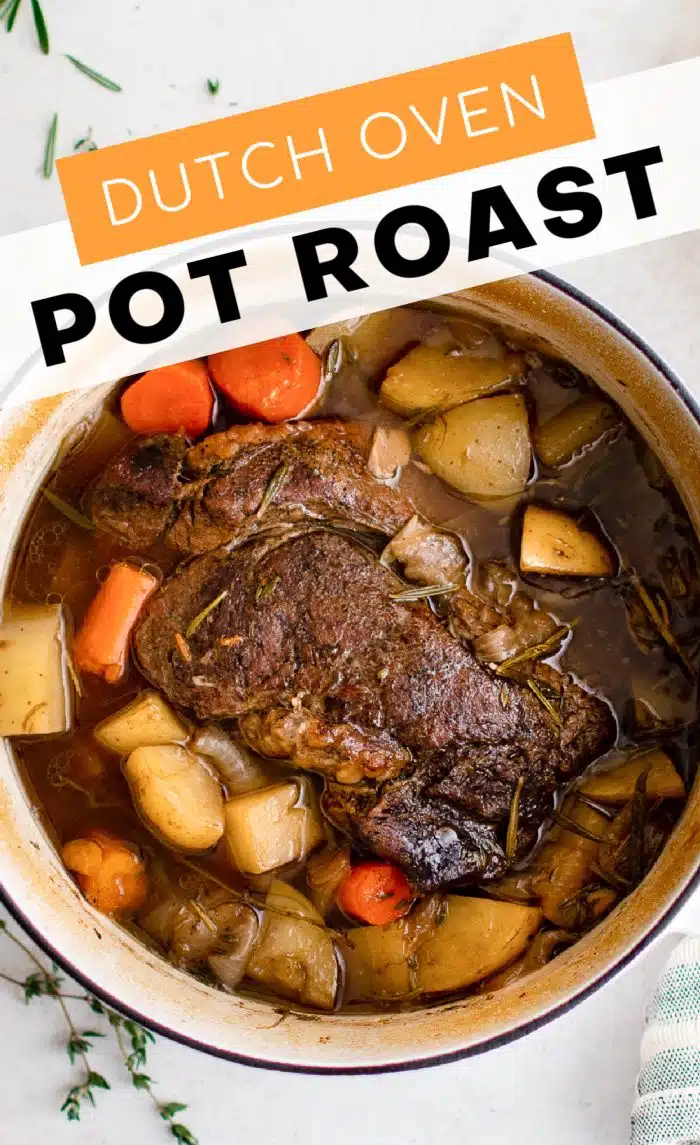

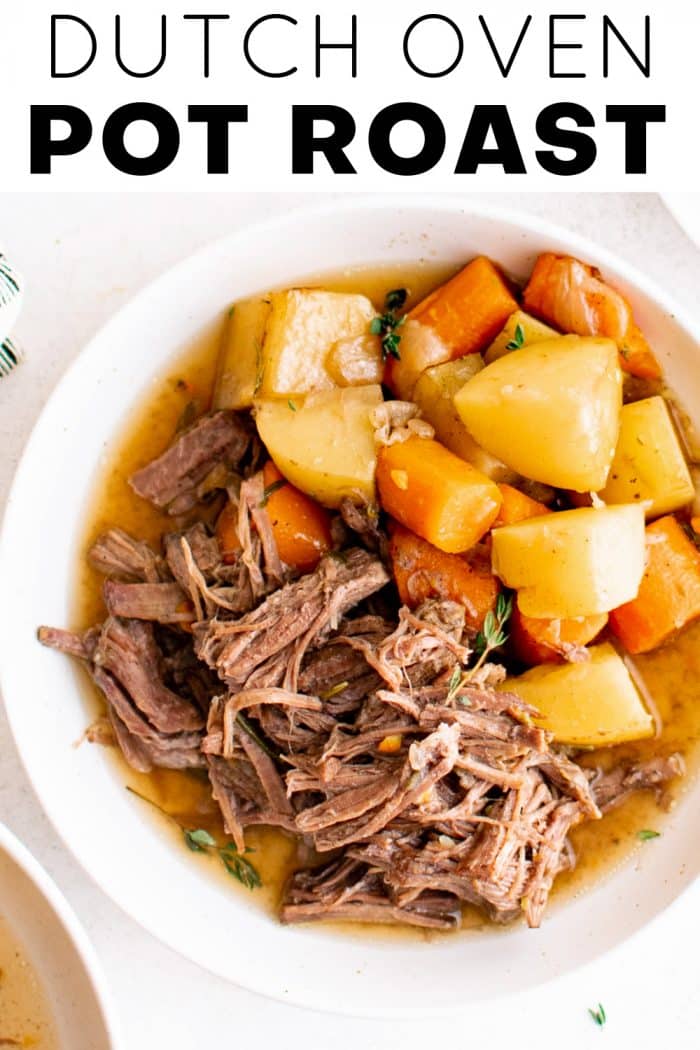

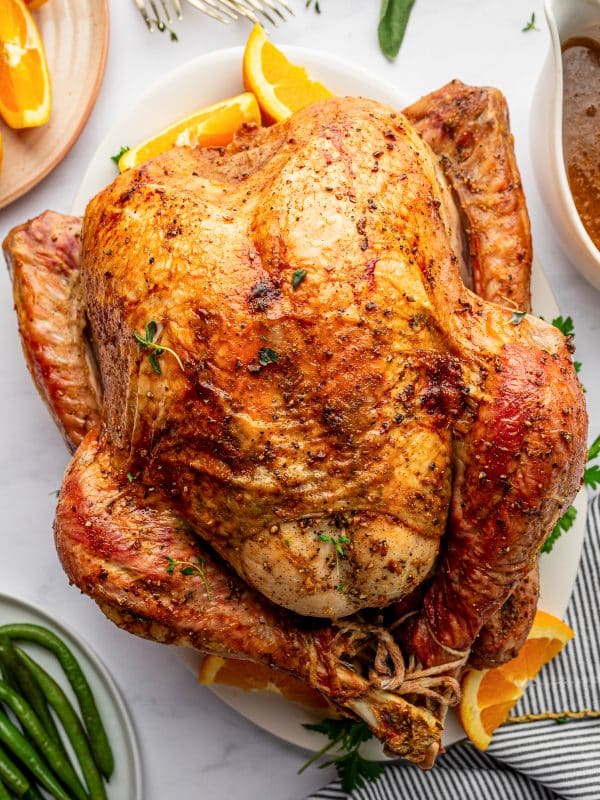
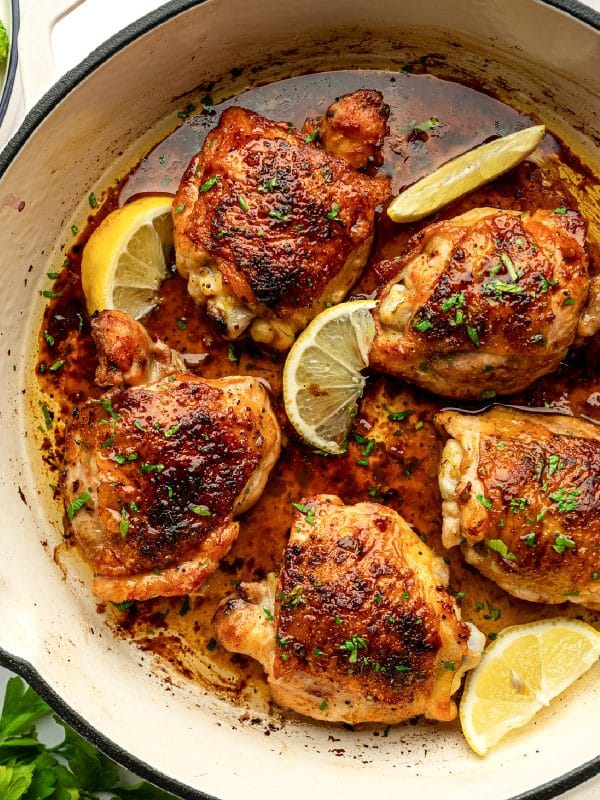
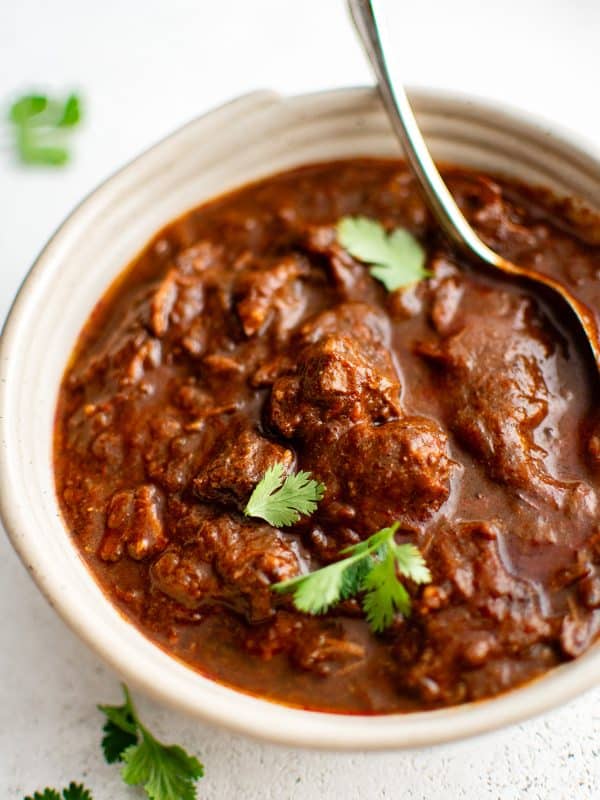
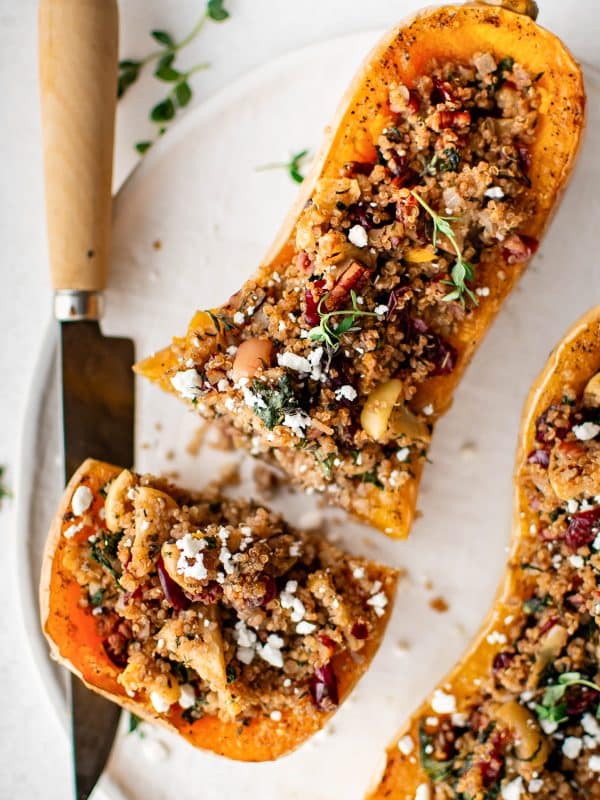








Delicious pot roast! I used Pinot Noir, added mushrooms and a few extra spices. Amazing flavor and texture.
I’m so glad you enjoyed the pot roast and put your own twist on it with Pinot Noir, mushrooms, and extra spices! It sounds like those additions really enhanced the flavor and texture. Thanks for sharing your successful modifications!
Have you ever tried white pepper on a chuck roast or do you reserve it for white meat ? I’m wanting to incorporate white pepper in some recipes and I was wondering if this would be a good cut of meat for it. Thanks.
White pepper can be an interesting addition to a chuck roast, offering a milder, earthy warmth that complements the rich flavors of the meat. It works well with other herbs and spices like garlic, thyme, or bay leaves, creating a balanced and aromatic dish. Using white pepper in your pot roast recipe could certainly enhance its flavor profile, making it worth a try if you’re looking to experiment with new tastes!
This recipe looks great! How would I cook this using a crockpot? Thanks for your help!
While I haven’t tried this, I would start by placing your seasoned roast and vegetables into the crockpot. Pour in the required liquids until they come about halfway up the meat. Cover and cook on low for 8 to 10 hours or on high for 4 to 5 hours, until the roast is tender and easily shreds with a fork.
I followed the recipe exactly and cooked in a Dutch Oven. It was quite yummy! My only comment: between the broth, the “salting” before browning and then the additional salt before putting it into the oven = TOO much salt! Next time, I will avoid that last tsp of additional salt.
I accidentally added the potatoes before I put it in the oven. Is that going to mess it all up? lol I realize it might over cook the potatoes.
Adding the potatoes early in a Dutch oven pot roast recipe isn’t necessarily a recipe disaster! Here’s what you can expect and some tips to manage it:
Softer Texture: The potatoes will cook for a longer duration along with the roast, which might make them softer and more broken down than if they were added later. This isn’t always a bad thing, as many enjoy the creamy, tender texture of well-cooked potatoes that have absorbed the flavors of the roast and its seasonings.
Flavor Absorption: Potatoes added early will have more time to absorb the flavors from the meat, herbs, and spices in the pot. This can actually enhance their taste, making them very flavorful.
Monitoring Cooking Time: Since the potatoes are in from the start, you might want to check on them partway through the cooking process. If they seem like they’re getting too soft or starting to fall apart, you can gently remove them from the Dutch oven and set them aside to be added back in for just the last bit of cooking to warm through.
Potential Solutions: If you’re concerned about the potatoes cooking too much:
Remove and Set Aside: As mentioned, you can remove the potatoes when they are just tender, and then add them back into the pot during the last 30 minutes of cooking.
Thicken the Sauce: If the potatoes do break down, they can help thicken the sauce, which might be a delicious accidental tweak to your pot roast!
Embrace the Outcome: Sometimes, a little mishap like this can lead to a new variation of a recipe that you might actually prefer. The important part is that the roast itself is cooked properly to your liking.
So, no worries about messing it all up—this could turn into a delightful twist on your Dutch oven pot roast! Enjoy the cooking experience and the flavors it brings.
Hey I am planning on making this, but in my grocery order, the store gave me a 2 lb roast instead of a 3 lb! Would you recommend reducing cooking time and/or the amount used of the other ingredients? Thanks! Can’t wait to try, it looks delicious.
First, I would click on the “5” Servings above in the recipe card, and reduce it to 3 to update the ingredient amounts.
Typically, a smaller roast will cook a bit faster, so you should check the doneness earlier than you would for a 3 lb roast. Reducing the cooking time by about 20-25% should be a good starting point.
It’s also a good idea to keep an eye on the liquid levels during cooking. A smaller roast might not require as much liquid, and you don’t want your dish to become too soupy or the flavors too diluted. Adjusting as you go is perfectly fine, and remember to taste and tweak if necessary!
I don’t have fresh rosemary or thyme. Can I substitute with dried and it will still come out alright ? Or I have fresh oregano.
Thanks !
When substituting dried herbs for fresh ones in a Dutch oven pot roast, the general rule is to use one-third the amount of dried herbs as you would fresh herbs because dried herbs are more concentrated in flavor. For your recipe:
– Substitute the 4 sprigs of fresh thyme with about 1 to 1.5 teaspoons of dried thyme.
– Substitute the 2 sprigs of fresh rosemary with about 0.5 to 1 teaspoon of dried rosemary.
Adjust to taste if necessary, but these measurements should provide a similar flavor profile to using fresh herbs.
This was amazing. I followed the recipe totally except that I used a half cup of red wine instead of the full cup and I didn’t have fresh thyme so i left that out. It was tender and tasty and all and all perfect.